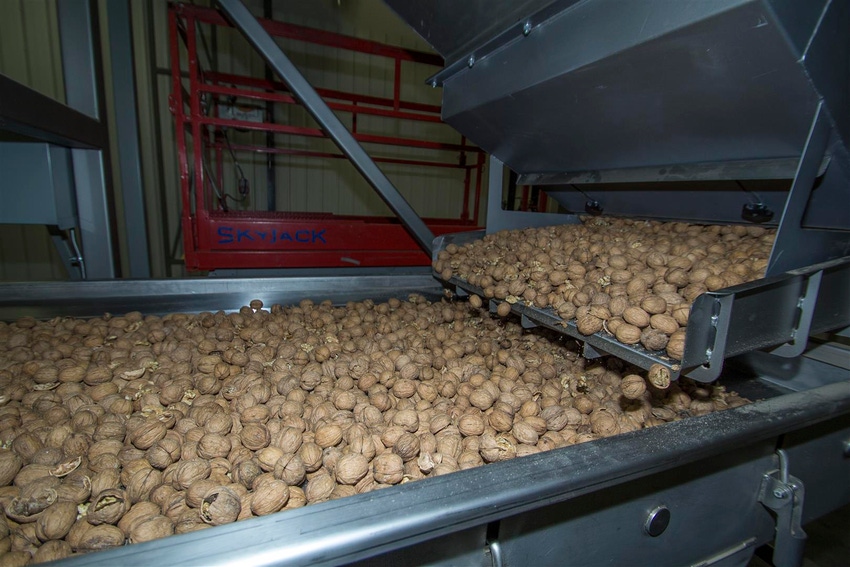
What one walnut industry expert calls a “perfect storm” of events may be behind recent reductions in California walnut exports.
Year-to-date figures released by the California Walnut Commission in early December show that in-shell exports of the 2014 crop were down nearly 21 percent compared to early-season sales from the 2013 crop.
Similar domestic consumption declines were reported.
According to the report, the bulk of the decline came from a 47.3 percent drop in shipments to Hong Kong for the same period – down from 58.6 million pounds of in-shell product to 30.8 million pounds.
Meanwhile, shelled product exports gained almost 5 percent in international shipments over the same period in spite of a 5.6 percent reduction in domestic sales.
Other major international buyers of California walnuts including Turkey and Italy reduced their purchases of in-shell walnuts during the period as smaller customers like Germany, Brazil, Australia and Thailand reduced purchases by even greater percentages.
Some countries including Greece, Jordan and Kuwait purchased no in-shell product during the period; even though combined they purchased over 661,000 pounds in the same period last year.
On the bright side, Egypt boosted its in-shell purchases over 426 percent to 232,035 pounds on the period and bought over 221,000 pounds, nearly 250 percent more shelled product at the same time.
By volume, Vietnam purchased more walnuts than China during the opening three months of the 2014/15 season – 18.6 million pounds versus 11 million – according to the report.
China is really a combination of three countries: China, Vietnam and Hong Kong, according to Tim Merrill, sales and marketing manager for Omega Walnuts in Orland, Calif.
Mainland China, Hong Kong and Vietnam combined during the period to purchase over 60.5 million pounds of walnuts from California, this compares to over 92.8 million pounds purchased during the same period last year.
Merrill says a sizeable portion of Vietnam’s purchases are smuggled into China because tariffs there are lower than in China.
“Vietnam simply cannot consume that many walnuts,” Merrill said.
Multiple factors
Merrill says a laundry-list of possible causes ranging from the strength of the U.S. Dollar relative to other world currency plus political unrest in Hong Kong may have played a role in the reduced walnut exports. There are also reports that China produced a record walnut crop, which if true, would have exceeded California’s 2014 harvest, which is projected at 545,000 tons.
Merrill expects that a December announcement by California walnut processors could cause further ripples in the walnut industry throughout the balance of the 2014/15 crop season. Last month processors suggested about 200,000 pounds of walnuts will remain unsold when the 2014/15 crop seasons closes.
That carry-in for the next marketing year already has markets rattled and signaled that nut prices were too high, Merrill said.
Further challenging the industry as the 2014 harvest was ending included a grower request for a 10 percent hike in prices over last year’s record high, Merrill said. Grower price demands preceded the December processor announcement, which has yet to reveal itself on position reports.
“If growers had kept the price at last year’s level they would have sold it all by now,” Merrill said.
Modesto-area walnut farmer Jake Wenger seemed to agree. He said walnut farmers “got spoiled” by the record-high walnut prices of last year and wanted more. This happened at the same time almond and pistachio growers were also enjoying record-high prices for their crops.
Wenger is not surprised that walnut buyers may want to sit back and see if prices soften before placing more orders. Even if prices soften to near, yet above $1 per pound to the grower, Wenger is confident he can continue profitably growing walnuts.
“If you can’t make money at a dollar you’re doing something wrong,” Wenger said.
Merrill remains optimistic about the California walnut industry, saying this does not this mean the industry will implode or become unprofitable in the short term. Meanwhile, he does see a likely slow-down in new plantings as growers wait to see if consumption increases continue and prices go back up.
Water availability could play a significant factor in the decision by growers to slow their rate of growth, he added.
The news appeared to be of little concern to the California Walnut Commission, which is funded by a mandatory assessment of growers to improve consumption of walnuts.
In a written statement by a public relations firm on behalf of the California Walnut Commission, the outlook remains optimistic.
“Global demand for walnuts remains strong and we’re confident that consumers throughout the world will continue to appreciate the culinary versatility and health benefits that walnuts provide,” the statement reads.
About the Author(s)
You May Also Like






